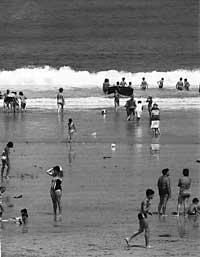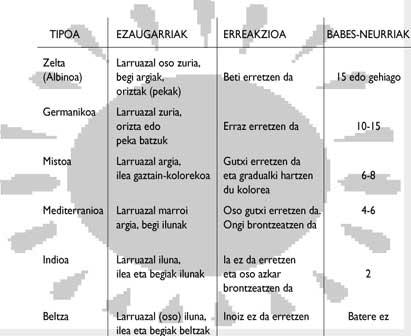Watch out for the sun!
When reading this number, reader, you probably were on the beach. Maybe several times. Have you taken appropriate protective measures? Or like every year, has your skin been golden or worse? What about the children? Keep in mind that children's skin is more delicate than yours and that all prevention measures are few for them if they want to avoid problems in the future.

Today it is clear that one of the main risk factors for melanoma is that during childhood the ultraviolet rays of the sun are taken for a long or short time, but in a hard exposure. This has proven very well in Australia. Its inhabitants have very clear skin and its climate offers thousands of hours of sunshine a year. According to data from recent years, the incidence of melanoma, that is, of the most malignant type of skin cancer, has increased considerably in this territory.
Maybe the start seems a little hard, a reader. But it is very important to make parents aware of the great damage that it means to put children in the sun without adequate protection.
Sunbathing is a good thing, but look! A few years ago the American Associations of Dermatology raised the hare with an intense and spectacular campaign: “We fry now, then you’ll pay.” If you close your eyes and imagine a beach, there you will see the children playing on the seashore, making castles, with live skin, without any protection. After a few hours, the sun's ultraviolet rays will show their effect: the child's skin becomes red, blisters or pusles appear (earliest sign of later erythema). We are facing a sunburn.
The above process will be the same for adults as for children, but it is the responsibility of parents to properly protect children. To do this, parents should avoid the most intense sunshine hours, especially noon, and long seasons, since the skin of the child is sensitive to ultraviolet radiation (and the smaller the child, the more sensitive). Therefore, the exposure of the first days will be a few minutes and we will gradually increase.

The Sun has its good side and that cannot be denied. It produces vitamin D synthesis, stimulates metabolism, relieves depressions and relieves some skin conditions such as psoriasis. However, according to specialists, and many people do not want to understand it, to get these benefits just start with a quarter of an hour and start two or three times a week. On the other hand, do not forget that the superficial layers of the skin are weaker in children, so the radiation that passes to the deep layer is greater and this makes the photobiological effects (redness, edema and, ultimately, burns) also greater in children.
Returning to the Australian territories, the fruits of the solar excesses suffered by several children in the 60s to 70s are now being noticed, since the main damage that the sun exerts on the skin is not perceived quickly, it is preserved for a long time and appears after the years. In view of the consequences (premature aging of the skin, spots, the rise of skin cancer), it can be said that people's attitudes have begun to change, since the skin of chocolate tone, which was obtained with the sun for hours and without any protection, is not fashionable today.
However, this has not yet prevailed among us and moderation is not well known in these places. We continue to commit abuses (sleeping on the beach or lying for long hours in the sun and almost always with a protection factor lower than recommended by prudence, with the intention of tanning before).

There are more factors to consider. Since the sun is always different for the skin (depending on altitude, season and time of day), each person's skin is also different from the sun. For children, the “quality” of the skin is inherited from their parents. In photobiology there are six different phototypes (from I to VI), from the albino to the black race, depending on their ability and ease to take the pigment (i.e., tan) and brown it. See attached table.
And you are a reader, of what kind? How many times will you burn this summer?
The best of the sun, the shade
I said it before. All American Dermatology Associations have unanimously discussed the measures to be taken: “Children, because of their activities and games, are more at risk and their defense mechanisms have not been fully developed, and they are even more sensitive.” So never put young children in the sun: if they are under 3 years of age carefully with the midday sun and always with special products and creams for children of high level of protection.
Our children have started to take the first rays of the sun in spring, and when summer comes it is necessary to protect their skin, for example with a t-shirt (and if the child is very small put a cap on the head).
Children will never realize the consequences of a day alone and in the sun at night or the next day. That is why they should be applied a protective cream with some frequency, since even if the child is in the shade, the rest reflects the solar radiation. They should also be given to drink frequently because they are easily dehydrated.

Most specialists recommend providing children with high protective factors (about fifteen to start with) and having only a few minutes in the sun (because they are necessary for vitamin D synthesis). Consider and act on skin types or phototypes mentioned in the table. Sunbathing may require eye protection, but be careful: do not wear prescription glasses, as the concentration of rays through the lenses can injure the retina.
The body has areas more sensitive to sunburn and especially the lips, nose, eye contour, shoulders, chest, breasts, arms, thighs, knees and feet breasts must be protected.
The solar bath produces sweating and by this way the mineral components (magnesium, calcium, iron, etc.) and as water and salt are lost, it is advisable to compensate for these losses; when we return home we will take a beautiful glass of water and the quarter of an hour the fruit juice that you like.






